- DF65 Accessories
- DF65 Deck Patches
- DF65 Hull & Deck Sticker Sets
- DF95 Accessories
- DF95 Deck Patches
- DF95 Hull & Deck Sticker Sets
- Hull & Deck Sticker Set plain
- IOM Accessories
- National Letters
- RC Laser Deck Fittings
- RC Laser Kit
- RC Laser Rig Fittings
- RC Laser Sails
- RC Laser Servos
- Sail Numbers
- Super Shiny Hull & Deck Sticker Sets
- Transmitter cover
- Create account
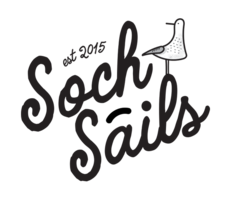
Sails & Accessories for Radio sailing
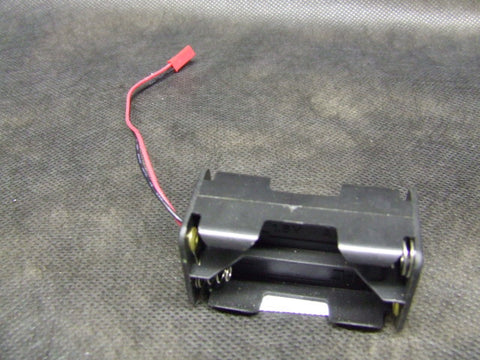
Battery Cradle
£3.00
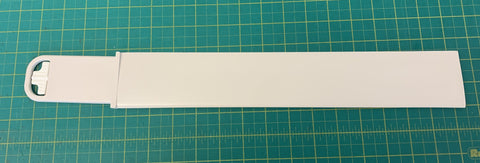
Keel Blade inc lever and spring
£12.00
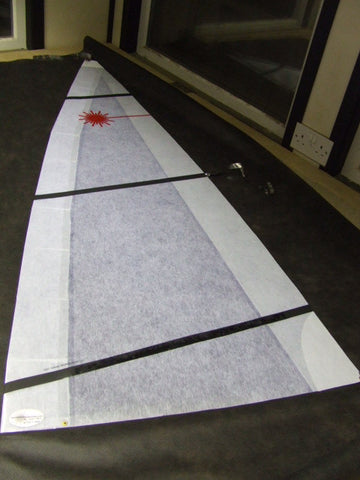
RC Laser A Rig Kit
£115.00
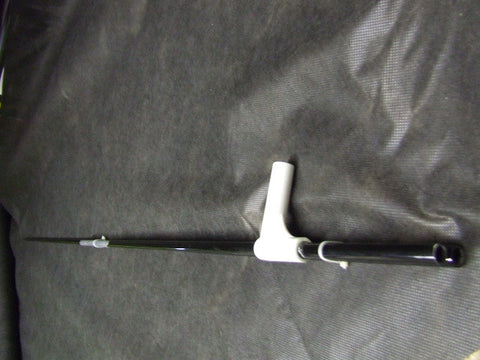
RC Laser A Rig Mast
£40.00
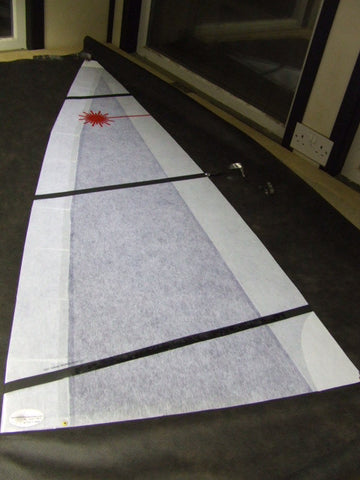
RC Laser A Sail
£55.00
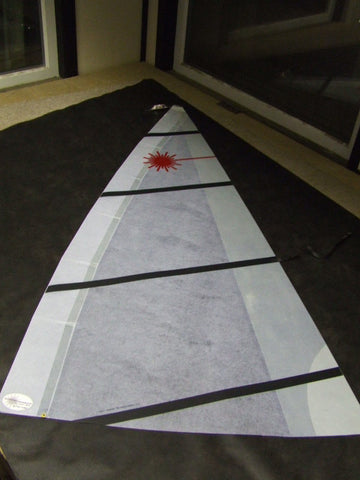
RC Laser B Sail
£52.00
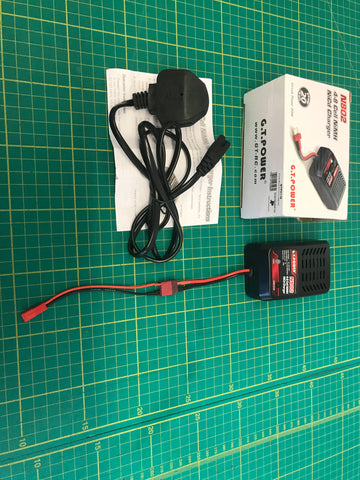
RC Laser Battery Charger
£15.00
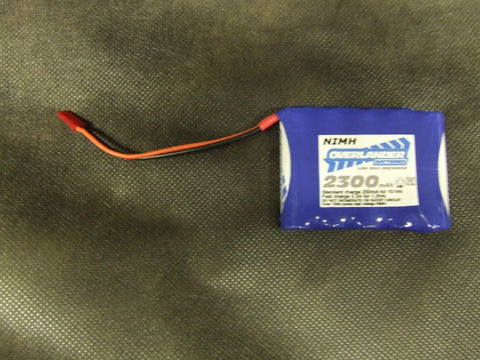
RC Laser Battery Upgrade
£19.00
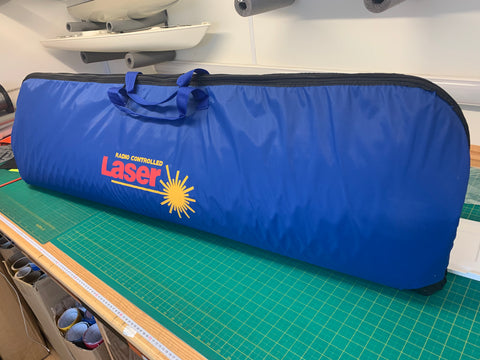
RC Laser Blue Carry Bag
£85.00
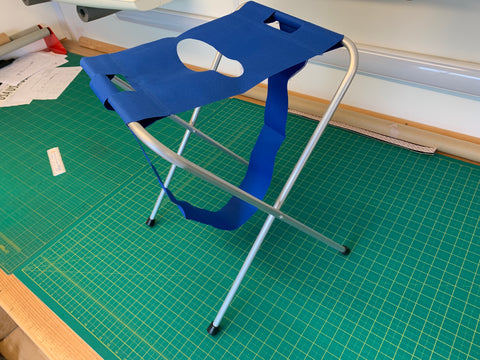
RC Laser Boat Stand
£30.00
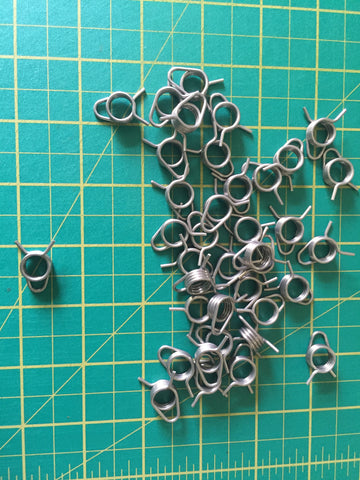
RC Laser Boom Slider
£2.20
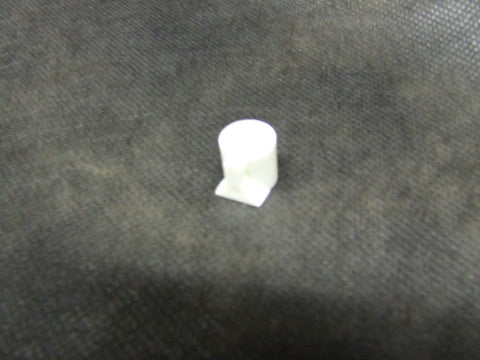
RC Laser Bottom Rudder Bush
£2.00
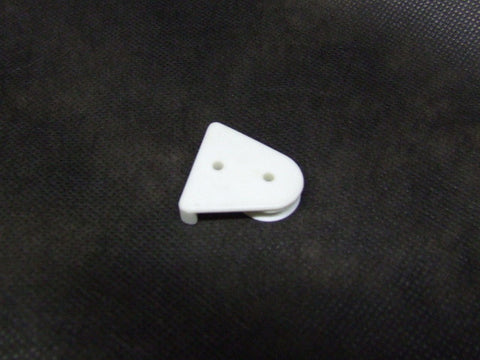
RC Laser Bow Pulley Complete
£5.00
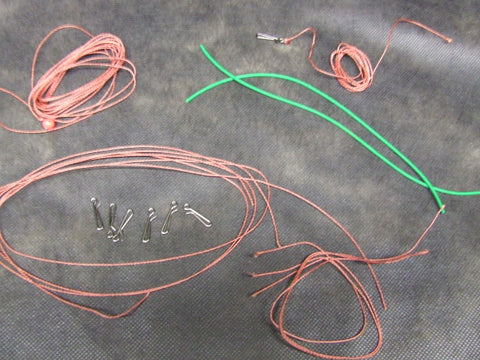
RC Laser Braid Upgrade Kit
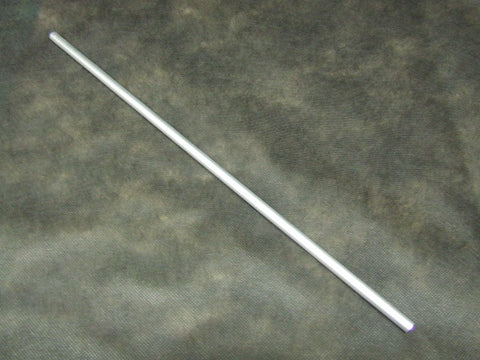
RC Laser C & D Rig Boom
£9.50
RC Laser C Rig Kit
£105.00
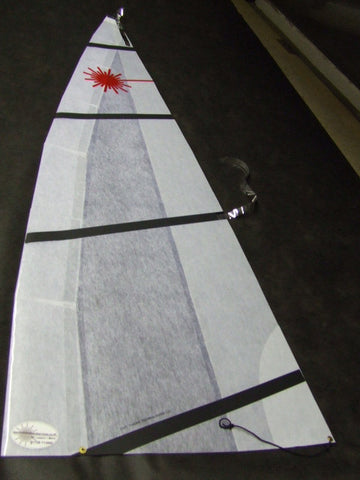
RC Laser C Sail
RC Laser D Rig Kit
RC Laser D Sail
£50.00
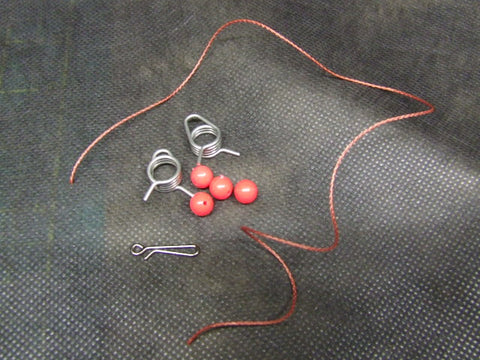
RC Laser Downhaul Kit
£6.40
- Hall of Fame
- Buy a RC Laser
- Pre-Owned Lasers for Sale

Buying a radio controlled RC Laser sailboat and accessories
So you want to buy a radio controlled RC Laser sailboat and come out to race but don’t know what you need to purchase to get started? Although there are many accessories you could purchase, in our opinion, we recommend you buy these four things to be competitive: the standard boat package, a transmitter, waterproof receiver and an extra light air sail.
Bottom line setup is about $694.
Buy the Plug-N-Play (PNP) version of the RC Laser and then pick up a Spektrum DX6i radio (MD2 version, no servos or receiver included) and the marine receiver locally or online. Click the links to view: RC Laser PNP $484.00 * Spektrum DX 6i MD2 Transmitter $159.99 * Spektrum MR200 Marine Receiver $49.99 *
If you are going to race at Canandaigua, you should also order the “A” sail rig that includes the tall mast and boom when you order your boat because most of the time we are racing in winds less than 9 mph.
“A” Sail & Rig $89.00 *
Shopping locally for your radio and receiver?
Dan’s Crafts and Things http://danscraftsandthings.com 352 Empire Boulevard Rochester, NY 14609-4454 (585) 482-7850
Here is a list of additional things you might consider.
“C” Rig for winds 18 – 28 mph “D” Rig for winds 28+ mph Hard shell, foam-padded box to store your transmitter Bag to holds all 4 rigged sails $175.00 * or call Skip Lippincott at (856) 764-8282.
*All prices were current when this page was last updated.
North American RC Lasers
- Canandaigua, NY
- Marco Island Model Yacht Club
- Nanaimo RC Laser Fleet # 17
- North American Class
- Ontario, Canada
- Palmetto Model Sailing Club, Columbia, SC
- PCYC RC Lasers, Salem, MA
- Rochester, NY
- Rock Hall Yacht Club RC Laser Fleet
- Space Coast Model Sailing Club
- TMYC, Raleigh, NC, Fleet 27
Worldwide RC Lasers
- Australia (Facebook)
- Banderas Bay RC Laser Fleet
- Czech Republic
- International RC Laser Class
- International RC Laser Forum
- South Africa
- United Kingdom
Hosts of the 2012 RC Laser North American Championship June 8-10, 2012

- Watertech Poolbuster
- Watertech Catfish
- Watertech Aquabroom
- Nirvana Sailboat
- H2O Speedboat
Developing Ideas Into Reality.

Designed by Out There’s Jon Elmaleh, the RC Laser is a radio-controlled version of the real-life Laser sailboat .
RC Lasers have been sold in the United States, Canada, the Caribbean, South America, England, France, Germany, Switzerland, Singapore, Thailand, Malaysia, New Zealand and South Africa. There is a close-knit RC Laser community, with clubs and races all over the world. There are also rental facilities in Montreal , Toronto, Minneapolis, Milwaukee , and New York’s Central Park .
For more detailed information, go to the official US RC Laser website for a wealth of information on this popular product.
Share this:
Brooklyn, New York
+1 (718)875-5678
© 2024 Out There Technologies. Built using WordPress and the Highlight Theme
Free Shipping Over $99* - 366 Day Returns - Dedicated Customer Support

- Call Us +1-503-285-5536
- Sign in & Register
- Recently Viewed
Restoring & Upgrading Laser Sailboats - Advice & Common Questions

Over 200,000 Laser sailboats have been built over the last 40 years, more than most other small dinghy sailboats. In this article we are going to answer some of the common questions we receive about the basics of Laser sailboat rigging, how to tell what size rig you have, what you can upgrade, and more. This information is designed for the recreational sailor who is simply looking to replace missing parts or install simple upgrades that make it easier to enjoy their boat.
As a note, we're going to make frequent reference to a rigging manual put together by Vanguard Sailboats about 10 years ago. We still refer to this guide often as it shows two different styles of rigging side by side, which is particularly helpful if you have an older boat you wish to upgrade.
You can view that rigging guide here: Laser Rigging Guide (opens in new tab)
What size rig do I have? Standard vs. Radial vs 4.7 Explained
The Laser sailboat has had a number of different rig sizes, with the intention of making the boat sailable by a wide range of sailors (and different sailor weights) by simply swapping out the lower mast section and sail while keeping all other components the same. There are currently three different rig sizes and they are commonly referred to as 'Standard', 'Radial' and '4.7'. Below you will find an image that shows the three rigs side by side, and in the following section we'll explain each one.

Laser Standard / MK2 / ILCA 7
This is the most common Laser rig size, and the original rig on the boat when it was designed. It features a 7.06 square meter sail (about 76 square feet). In 2018, the Laser Class approved a new 'Standard' sail, which is referred to as the 'MKII' or 'Mark 2' to distinguish it from the first version. The difference, among other things, is in the panels. The original 'Standard' sail featured horizontal cut panels. The new MkII sail has radial cut panels. There is no difference in size between these two versions, and as of 2020 all new Laser Standard sails are available in this updated cut.

How to tell if you have a 'Standard' sail: The first and most obvious way to tell if you have a 'Standard' sail is to look at the panels. If they are horizontal, it is most likely a standard sail. Next, you can measure the luff (the front edge of the sail along the mast sleeve). This measurement should be about 5130 mm or 200 inches from the top of the sail to the bottom.
How to tell if you have a 'Standard' lower mast section: The 'Standard' lower mast section should measure about 2865 mm or 113 inches . It is a fairly stout mast section compared to the two smaller mast sections.
Laser Radial / ILCA 6
Originally called the 'M' rig when first designed, the Laser 'Radial' sail is smaller than the 'Standard' sail at 5.76 square meters (62 square feet). At the time, it was the only Laser sail to feature the radial cut panels, which allowed the sail to be de-powered more easily in bigh winds. Per the notes about the 'Standard' rig above, both the Standard and Radial sail feature the radial cut design. Another typical indicator of a Radial size sail are the blue panels at the tack and clew of the sail.
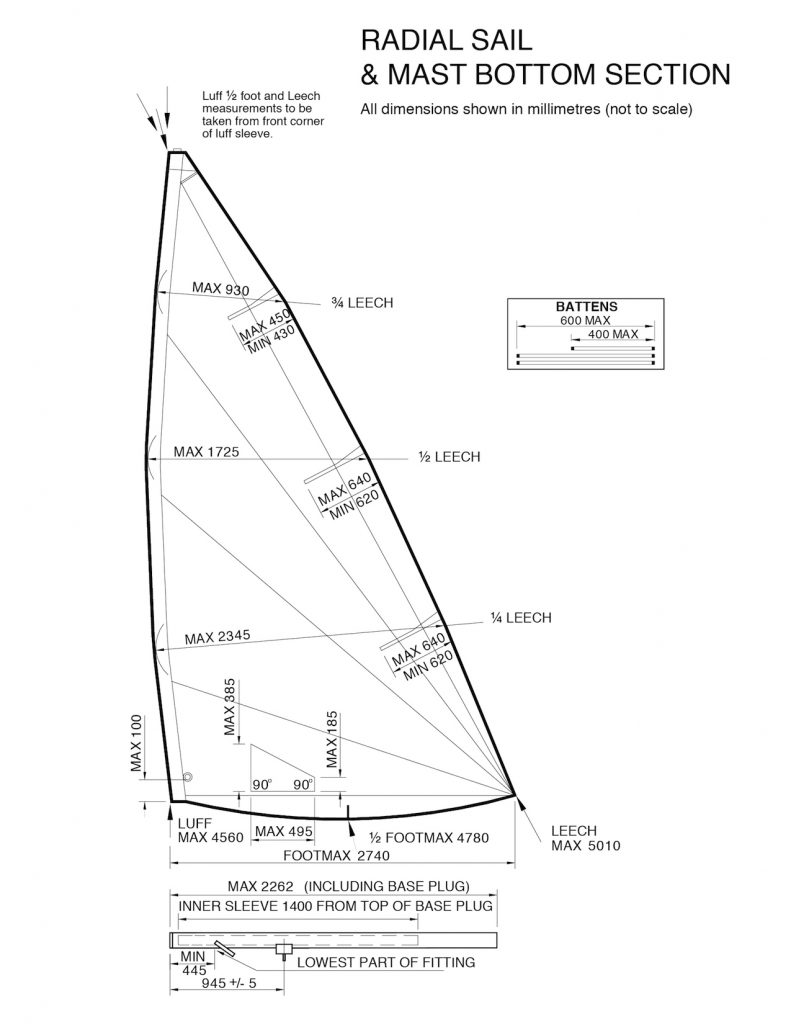
How to tell if you have a 'Radial' sail: The first and most obvious way to tell if you have a 'Standard' sail is to look at the panels. If they are radial, as in emanating out from the center, it is most likely a radial sail. Next, you can measure the luff (the front edge of the sail along the mast sleeve). This measurement should be about 4560 mm or 180 inches from the top of the sail to the bottom.
How to tell if you have a 'Radial' lower mast section: The 'Radial' lower mast section should measure about 2262 mm or 89 inches . It is also a bit smaller in diameter than the standard section.
Laser 4.7 / ILCA 5
The Laser 4.7 (or ILCA 5) is the smallest of the three Laser sails and was designed for young sailors just getting into Laser sailing. The 4.7 lower mast section is also different from the others in that is has a pre-bend near the boom fitting, allowing the sail to depower much easier. This is the least common Laser sail size, and if you have an old one around, chances are it is not a 4.7 sail.

How to tell if you have a '4.7' sail: The 4.7 is similar to the old 'Standard' sail as it has cross cut panels. Many 4.7 sails also have an obvious 4.7 logo somewhere on the cloth. Next, you can measure the luff (the front edge of the sail along the mast sleeve). This measurement should be about 4080 mm or 160 inches from the top of the sail to the bottom.
How to tell if you have a '4.7' lower mast section: The '4.7 lower mast section has a pre-bend in it and should measure about 1810 mm or 71 inches . The bend is the easiest way to tell it apart from the others.
What is the difference between 'Race' and 'Rec' rigging?
Up until about 20 years ago, the Laser featured very basic boom vang, outhaul, and cunningham controls. These were basically just long lengths of line with a series of loops and knots designed to create 'purchase' or pulling power to help tighten the controls and further shape the sail. In many ways, these rudimentary controls limited the type of sailor who really excelled in terms of performance, as you needed to be very strong and athletic to control the boat (you still do at the very top of the racing scene, particularly if you hope to compete in the Olympics). If you have a 30+ year old boat that hasn't been updated, chances are it is a 'rec' rigged boat. There is no problem sailing a Laser like this and many sailors enjoy the simplicity of the rigging and low cost of replacing line and parts.
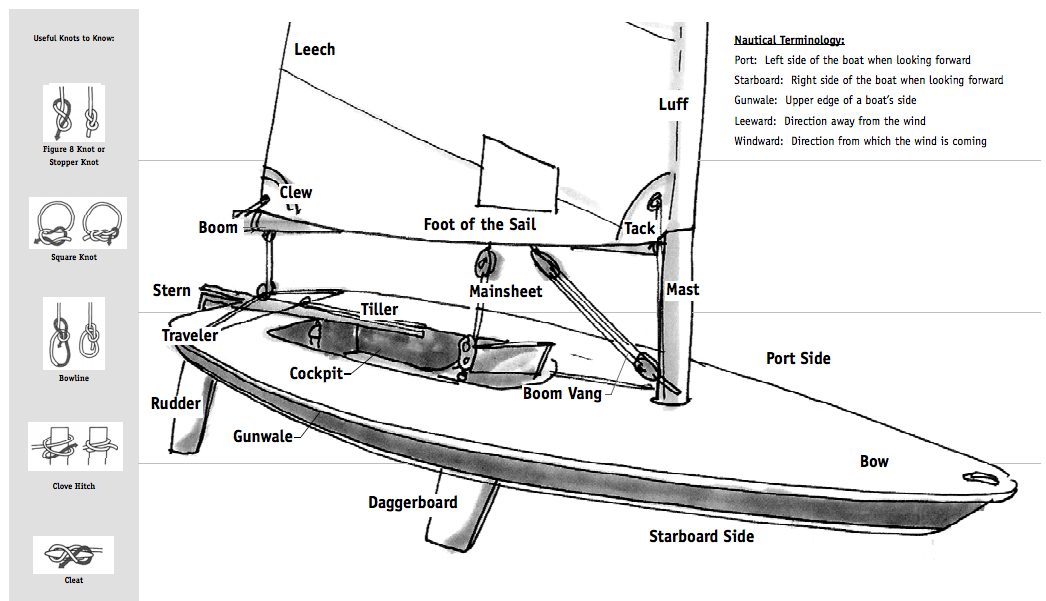
In 2000/2001, a new set of controls was approved, designed to make it easier to manipulate the sail (particularly for lighter sailors) and to rig/unrig the boat. These included a 15:1 boom vang, 8:1 cunningham, and 6:1 outhaul system. What was introduced at this time was and is still referred to as the 'Race' or 'Pro' set up, as opposed to the 'Recreational' or 'Standard' set up found before 2000. Between 2000 and 2010, many active Laser sailors upgraded their existing boats to this new standard with a series of kits (these are still available) and new boats started to include them. Starting in 2008/2009, basically every new Laser sailboat included some version of this upgraded Race rig set up. Lets take a look at how to quickly tell if your current boat is set up as a 'Race' or 'Rec' boat and then some of the differences between the two set ups.
Deck Hardware: Differences Between Race & Rec
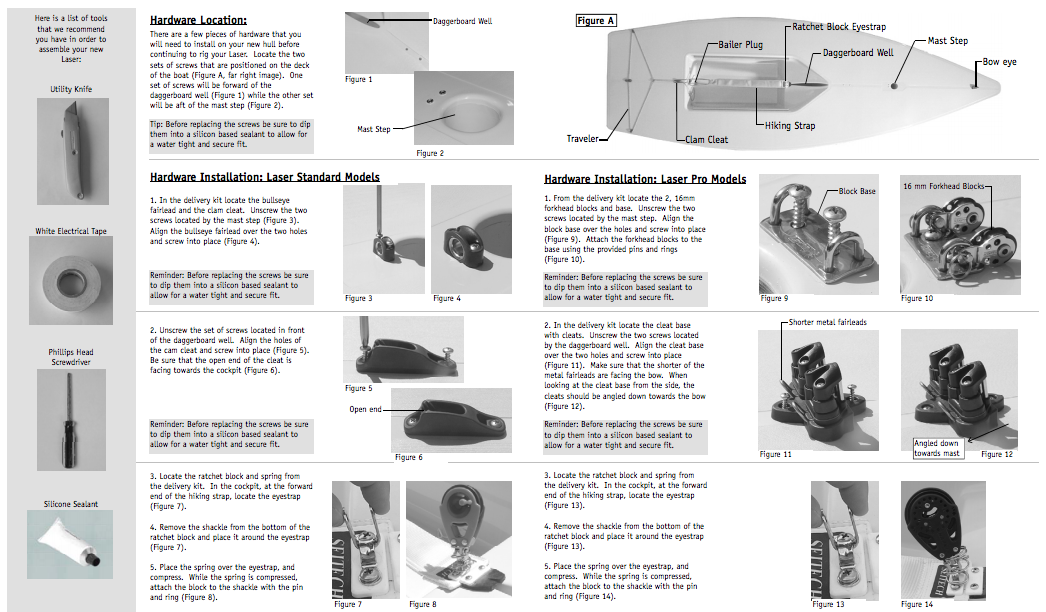
The most common question we get is how do I tell if my boat is set up with Race or Rec equipment? The quickest way to find out is to look at the hardware mounted on the deck of your Laser. Refer to the image above.
The 'Rec' setup (or 'Standard') is shown on the left , and the 'Race' set up (or 'Pro') is shown on the right. The Rec set up features a single bullseye fairlead just aft of the mast step and a single clam cleat just forward of the daggerboard trunk. These two pieces of hardware are for the cunningham control line.
The 'Race' setup (or 'Pro') is shown on the right , and features more advanced hardware. This hardware includes a deck plate with blocks just aft of the mast step (replaces the single fairlead) and a dual deck cleat in place of the single clam cleat. This new system allows both the cunningham and outhaul line to be lead down the mast and back to the cockpit for easy cleat/uncleat and adjustment from the new deck cleat system.
Insider Tip: Upgrade to 'Race' Rigging with just two kits! Back in 2000, Laser builders knew that sailors with existing boats would want a way to quickly upgrade from the 'Rec'/'Standard' rigging to the upgraded 'Race' rigging. For this reason, we still offer two kits just for this purpose.
- Laser Outhaul / Cunningham Upgrade - This kit includes everything from the blocks, cleats, hardware, line, blocks and instructions to fully update an older Laser to the latest outhaul and cunningham controls. This is the easiest way to upgrade your boat, though you will need a few basic tools to remove the old hardware from the deck and install the new components. In terms of an upgrade, this is one of THE BEST you can do to make your Laser easier to sail and to control in strong breeze.
- Laser Vang Upgrade - Upgrade to the latest 15:1 vang, no tools required! This vang system connects the same way as your old one (with a pin at the tang on the mast and with a 'key' to the fitting on the boom) and can be ready to go in minutes.
Deck Hardware: Shared Components Between Race & Rec
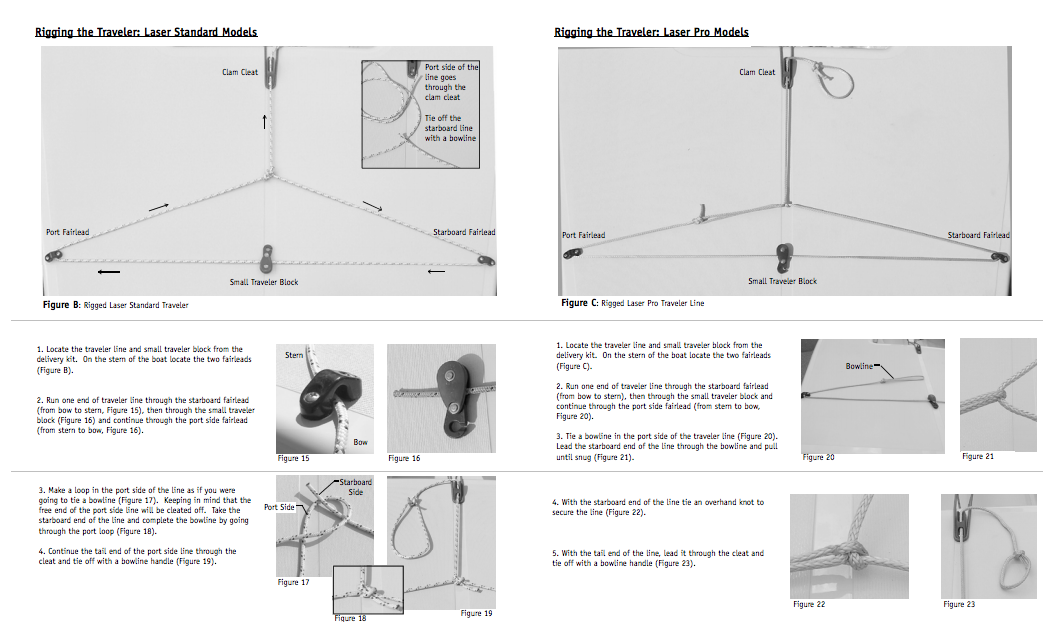
The rest of the hardware on a Laser deck is the same, regardless of what rigging specification you use. The image above shows the traveler set up, which consists of two fairleads mounted on the back corners of the boat and a single cleat mounted just aft of the cockpit on the deck. There are a few components to this area we'll mention here for your reference:
- Fairleads - Depending on the year of your Laser, you'll need either a 23mm Fairlead (found on most older boats ) or a 26mm Fairlead . We also have replica versions of both the 23mm and 26mm fairleads.
- Cleat - A single aluminum clam cleat is used for cleating the traveler. We recommend the CL221 Cleat .
- Traveler - We recommend 11 feet of a low stretch line. You can also purchase our premium Vectran Traveler with has a nicely spliced eye on one end.
Mainsheet System & Blocks
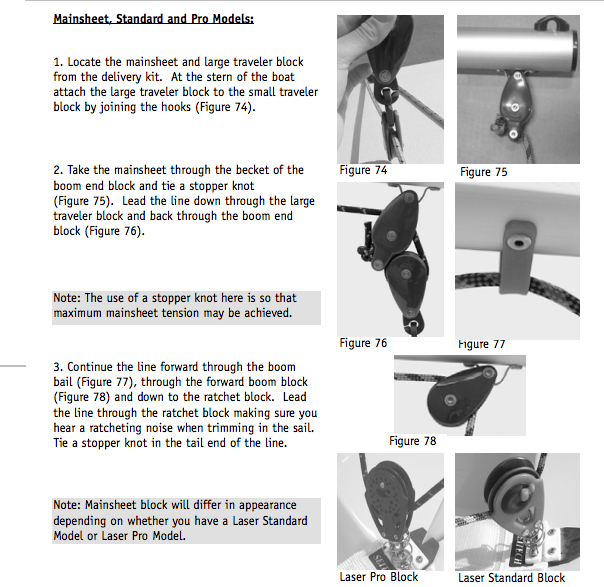
Regardless of specific rig set up, the Laser mainsheet is rigged the exact same way. The mainsheet system includes a ratchet block attached to the deck just forward of the cockpit, two blocks mounted on the boom, and a set of traveler blocks at the rear on the deck. There are a few different components and some upgrades we'll reference here.
- Mainsheet Ratchet Block - You can use any ratchet block here that is designed for a 6-8 mm line (the desired range of diameter for a Laser mainsheet). We recommend:
- Harken 57mm Ratchet Block
- Ronstan 55mm Orbit Block
- Mainsheet Spring
- Eyestrap (Stainless)
Boom Vang: 15:1 Race Vang vs 3:1 Rec Vang

The Laser boom vang is a series of blocks and line that connect to the boom with a key style fitting for quick removal and to a tang fitting with a pin at the base of the mast just above the deck line.
- Rec Vang (3:1) - Sometimes called the classic vang, this is a simple '3:1' purchase vang system with two blocks and a length of line. Here are the components.
- Classic Vang Block Upper
- Classic Vang Block Lower
- Classic Vang Assembly
- Classic Vang Line
- Race Vang (15:1) - Sometimes called the pro vang, this is a more powerful '15:1' purchase vang system with more turning points. It uses both a covered control line and pure dyneema/spectra line for strength. This is available as a full upgrade kit in a few different versions for easy install to your Laser. It is easier to install than the Outhaul/Cunningham kit as there are is no deck hardware to install - simply clip in the same way as your old vang.
- Harken Laser Vang Upgrade
- Vang Becket Block - Used at the top of the Harken Vang assembly
- Practice Vang Upgrade (Generic)
- Shared Components - There are a few pieces of hardware used on the boat regardless of what vang you have.
- Laser Vang Tang - Attached to lower mast section for connecting lower part of vang to mast
- Laser Vang Strap - Attached to boom for connecting top part of vang to mast with the key fitting via the slot
Outhaul Control System

The outhaul controls the back corner, or the clew, of the sail. The 'rec' / classic rigging is quite simple, whereas the 'race' rigging adds more power to the sail control, making it easier to adjust and flatten the sail to depower in heavy wind.
- Rec Outhaul - Uses a 10 foot length of line and the clam cleat on the boom to achieve a basic purchase system for tightening the sail. The entire control exists right on the boom.
- Race Outhaul - The upgraded race outhaul system has a few variants, but adds twice as many turning points for a more power purchase system. It uses two sections of line, a primary dyneema or spectra line in the rear and a secondary covered line in the front, which is lead down to the deck cleat for easy adjustment.
- Harken Outhaul/Cunningham Kit - Includes everything, down to the deck hardware, for adding the upgraded Outhual and Cunningham set up to your existing Laser.
- Practice Outhaul/Cunningham Kit - A less expensive alternative to the Harken kit from Allen.
Cunningham (Downhaul) Control System
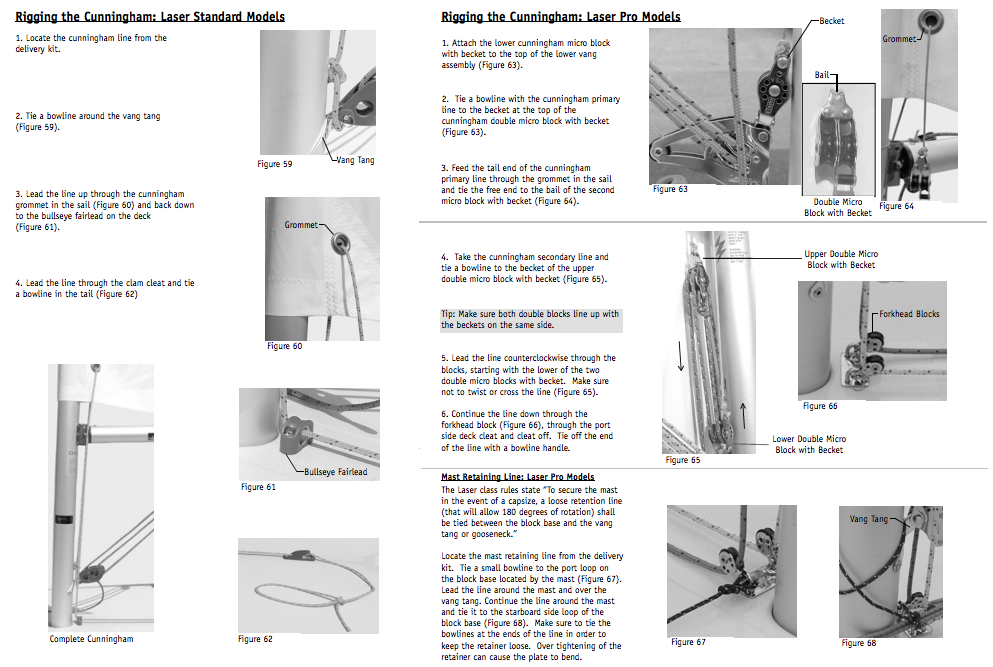
The cunningham, sometimes called the downhaul, controls the front edge of the sail The 'rec' / classic rigging is quite simple, whereas the 'race' rigging adds more power to the sail control, making it easier to adjust and flatten the sail to depower in heavy wind.
- Rec Outhaul - Uses a 10 foot length of line and the single clam cleat on the deck. The line is tied around the vang tang, up through the tack grommet, down to the fairlead, and back to the clam cleat for adjustment.
- Race Outhaul - The upgraded race cunningham system also has a few variants, but creates a powerful 8:1 purchase system. It uses two sections of line, a primary dyneema or spectra line to pass through the tack grommet and a coverer secondary line which is fed through the blocks and lead down to the deck cleat for easy adjustment.
- Harken Outhaul/Cunningham Kit - Includes everything, down to the deck hardware, for adding the upgraded Outhual and Cunningham set up to your existing Laser.
- Practice Outhaul/Cunningham Kit - A less expensive alternative to the Harken kit from Allen.
Subscribe To Our Newsletter
Sign up for our newsletter to receive exclusive discounts, new product announcements, and upcoming sales.

- Laser Performance
Laser Sailboat Class Legal Parts
When you need a wide range of sailboat gear and hardware, no brand is quite as versatile as Laser. From Laser sailboat parts, spars and Laser sailboat accessories to control systems, lines, blocks, wind indicators, full blown Laser sails, and sailboat covers, you'll find a solution to your boating needs great or small. Laser sails are offered in full rig, radial and 4.7 sizes to meet the needs of your yacht whether it's for cruising or racing.
Grab all your Laser sailboat parts, sails, and accessories from Vela Sailing Supply and save big with free shipping in the Continental United States on all orders over $90!
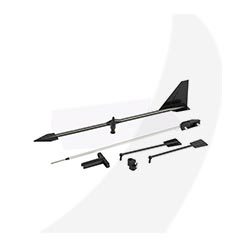
ILCA Laser Hull Cover by Storm
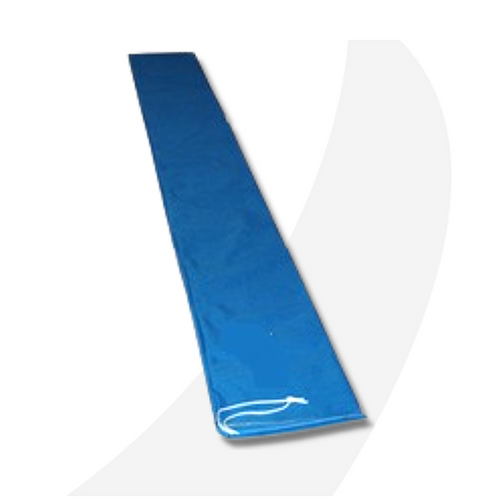
LASER ROLLED SAIL BAG

Laser Performance Laser Hiking Strap by Seitech
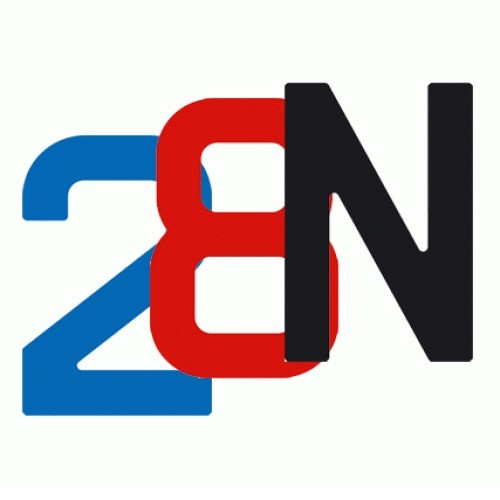
Laser Sail Numbers & Letters 12 in.

Sunfish Sail Numbers & Letters 12 in.

Laser 4.7 Sail Numbers & Letters 10 in.
Last Updated on March 7, 2023 by Brendan
- 1 Why Choose an RC Laser Sailboat?
- 2 RC Laser Specifications & Features
- 3 Different Kinds of Rigs
- 4 What You Get/Assembly Details
- 5 Where To Purchase
- 6 Popular And Affordable
- 7.4 Australia
- 7.5 Other RC Sailing information:
- 8.1 More From My Site
The RC (Remote Control) Laser sailboat is one of the easiest model yachts to assemble and operate. It is a scaled-down (1/4 size) version of the real boat – the famous racing Laser dinghy, which is the most popular sailing class in the world. The RC Laser Sailboat version of this boat was intended to be simple so that those who are new to the sport would find it relatively easy to get into due to affordability and ease of use.
However, just because it is easy to learn doesn’t mean it is easy to master. And this is one thing that makes it so appealing to sailors of all different ages and abilities.
The full-sized racing Laser dinghy was designed by Canadian sailor/yacht designer Bruce Kirby. Kirby has appeared in three Olympics and also designed two America’s Cup Defenders. The Laser is his most popular and best-known design. In fact, well over 200,000 of them have been built which makes the Laser the all-time most popular racing class. Read more about the full-sized laser dinghy here .

The RC version of the Laser was created by RC yacht designer Jon Elmaleh who has been one of the top designers of remote-controlled boats since 1982. He has also earned well over 30 championships in national RC racing events. His technical design skills partnered with practical racing experience aided in the final RC Laser product.
Why Choose an RC Laser Sailboat?
The RC Laser sailboat is an exciting way to get into the world of RC boats. The Laser is a very simple boat to operate and does not have the complicated hardware of other RC boats making it easy to assemble. There are no stays holding up the mast. The simple design makes it quick and easy to change rigs when the conditions vary… taking no more than a few minutes.
The RC Laser sailboat is also very durable and can be operated in almost any size body of water, including small ponds, bays, and lakes. The RC Laser sailboat is a great sailboat for kids and adults and is a perfect model for racing, and is good for anyone interested in remote control boats.
Similar to the full-sized version, all dinghies are the same, which makes for competitive racing. However, because of its simple design, it is relatively easy for beginners as well. This versatility makes it a popular choice for people of all experience levels.

RC Laser Specifications & Features
All RC Lasers have the same dimensions. Some of the Laser’s specs and features include:
Different Kinds of Rigs
The Laser RC sailboat has a total of four different sails/rigs and each rig setup requires a slightly different mast and boom combination. As complicated as this may sound, it really isn’t and once you get the hang of it, you’ll be changing rigs quickly and with ease.
Many RC Laser Sailboat sailors actually own all 4 rigs (ie. 4 x masts, 4 x booms, 4 x sails – all rigged up and ready to go) so that they are able to pick the best rig for the conditions. If the conditions change throughout the day, then all the owner has to do is bring the boat to shore, unclip the mainsheet on the used rig and remove the rig, insert the new rig into the mast slot, and clip up the mainsheet on the new rig, and launch the boat. This means minimal time is wasted between races and gives the owner the best chance of being competitive.
Essentially the wind speed will help you to determine which rig setup to use. There may also be times when you will be able to run a bigger rig for a longer period of time as your sailing/skipper skills improve.
You can see the different sizes of the 4 rigs in the photo below (The A-rig is on the left, through to the D-rig on the right)

What You Get/Assembly Details

Believe it or not, an RC Laser sailboat has just five parts and can be rigged and unrigged in less than 5 minutes after your first assembly. The shipping box it arrives in has all the parts and you can put them together without the assistance of any tools. The hull, keel, rudder, mast, and sail all fit together easily and are designed specifically to be quickly launched, or so you can change rigging quickly to address different racing conditions.
Speaking of launching, all you need is a few feet of water and a gentle breeze. So, in other words, you can sail or race virtually anywhere there is some water. This includes a pond, lake, harbor, and even a swimming pool. Because of the efficient design, even a very light breeze can produce enough wind for your sailboat to work.
When it’s time to pack up and go, the RC Laser comes apart quickly and stows away in a padded boat bag that keeps everything in place and secure for any kind of travel. It is also compact and lightweight so you can carry your packed sailboat over your shoulder, in the trunk of a vehicle, or as luggage on a plane. It is that easy to take your hobby with you wherever you go.
Have a look at the video below to see how quickly and easily you can rig your RC Laser Sailboat (and if you have the rigs all set up to go, you can rig your Laser in about 1/2 the time in the video)…
Where To Purchase
Probably the best option when looking for an RC Laser for sale is to shop online. This is probably your best bet when you are trying to access everything from a used sailboat in good condition all the way to a new one. Plus, if you are in the market for accessories or replacement parts, you will be able to find whatever you need online. As for electronics, you can purchase most gear in most hobby/electronics stores.
Another source for locating new or second-hand sailboats is at a local yacht club, by asking around or on the noticeboard. Depending on the size of the community and proximity to water, many cities and regional towns have RC Yacht Clubs as well. The sailors/skippers in these clubs may have contacts that can help you locate what you are after.
Another option, hobby shops are where you may be able to find an RC Laser sailboat for sale.
Popular And Affordable
As mentioned above, the RC Laser Sailboat is very popular. The reasons vary but most of it has to do with the fact that there are clubs set up so that you can actually race against others with identical boats (similar to the actual full-sized laser world-class racing dinghy). Being remote control, it is easy to learn (but can be difficult to master) and people of all ages and fitness levels can race. The interest in racing also spans generational boundaries with parents, children, and even grandparents racing each other on a family outing.

What has assisted in cementing the racing relationship of RC boats with real sailors is the formation of RC Yacht Clubs. Some are under the umbrella and share facilities with regular yacht clubs whereas others are stand-alone groups. The reasonable cost of RC Laser sailing is also what attracts people with a basic new starter kit running between $500 and $1,000.
One great way to connect with other RC sailboat owners is through social media and the internet. There are several pages on Facebook dedicated to the hobby as well as YouTube videos showing how they handle and how competitive racing these remote control model boats can be. See the video and links below for some good resources.
For More Information Visit These Websites
https://rclaser.org.uk/ contains information on news, events, and clubs around the UK, as well as other general RC Laser Sailboat information.
In Western Canada, the largest group is the NanaimoRC Laser Fleet 17 in British Columbia. Their website includes a schedule of upcoming racing events and has results posted from previous ones.
In the United States, there are quite a few clubs to check out. Have a look at https://rclaser.org/ for starters. It has a good list of clubs and events around the USA.
RC sailing is huge in Australia and some of the best sources for information on events, buying a boat and anything else you may need to know are at http://radiosail.com.au/ and https://rcyachts.net/classes/rc-laser/ .
Other RC Sailing information:
In addition to the above sites, other great places to find out more about RC sailing include –
- American Model Yachting Association
- Canandaigua Lake RC Laser Sailing
- Australian Radio Yachting Association
- Radio Control Sailing Australia Facebook Page

Your Laser RC Sailboat Is Waiting
Remote-controlled sailing is much more than just a hobby – it’s a sport that a complete world of competition has been built around. Included in that world is a lifestyle that brings families and friends together.
It can be as casual or as competitive as you desire and what makes RC sailing with a Laser RC boat most interesting is that it is fun for everyone.
Author note: Thanks to Graham, Steve, and the other gents down at Dobroyd Aquatic Club for sharing their time and RC Laser Sailboat expertise with me. They were very welcoming and willing to give their time and explain things in detail, just as many of the other club members around Australia and the rest of the world would be to RC sailing newbies, I am sure.
So if you want to know more about RC Laser sailing, have a look at the links provided above. And why not drop down to your local club and have a look for yourself and chat with the locals.
More From My Site
About Brendan
Brendan has over 30 years experience sailing dinghies, yachts, and windsurfers, but has recently started Laser sailing. "I found it difficult to find all the information that I needed when I started sailing my Laser, and I am sure that others have had the same problem. So I combined all the information I could into this website to help other Laser sailors get the most out of this sport. If you have any questions or comments, let me know... I will get back to you as soon as I can."
15 Comments
What a great site! The RC Laser is certainly the best value for anyone looking to get into radio controlled boats. There are cheaper models but the longevity of the RC Laser puts it out in front. It is easy to sail but a real challenge to race. Great fun.
Hi Peter Thanks for your message and comments. I think what you said “ easy to sail but a real challenge to race ” is what makes it so popular amongst so many people, and is similar to what makes the full-sized laser dinghy such a popular option also. I think it’s good to have something that you are not able to master in 2 seconds, but rather something that challenges you and you grow and learn in the process. Thanks for sharing your thoughts. Brendan
When sailing down wind the bow starts to going under water. Is there anything I can do to stop this?
Hi Bob. Thanks for your question. Due to the forces acting on the boat, this is to be expected to some extent. When sailing downwind, you have the sail pushing forward, and the drag of the boat moving through the water pushing in the other direction. This creates a turning moment, which can tend to push the bow down. In full sized dinghies and yachts, you can obviously counteract this by moving your weight back, but unfortunately you can’t really do this well with RC sailboats. A couple of things that you may be able to do include trying to avoid running into the back of waves (as this slows the boat down, and increases the turining moment which pushes the bow down). Another issue may be that you are overpowered, so you may want to try a smaller rig. Also, please have a look at this article which explains nosediving in more detail. Although it does not specifically talk about RC Lasers (it focuses on the International One Meter class, or IOM), the principles are the same. There may be other RC laser sailing experts out there that have some other ideas, so I would be interested to know their thoughts. Hope this helps a little. Cheers Brendan
hallo. My name is kenneth. I Im from Denmark. I just bord a rc laser. Do you know any one from Denmark who is sailing??? I would like to race. Have a nice day.
Hi Kenneth Thanks for your message. I did a quick Google search and found this site – http://modelsejlklubben.dk/ . It looks like they do not only race RC Lasers, but race all types of RC yachts. I am not aware of any other clubs that race RC Lasers in Denmark, but I would say that you would be best to just do a few Google searches for things like “RC Laser Sailing” or “rc laser sailing club”. Otherwise, if there is a sailing club near to where you live, why not go down there and ask around – some of the locals may know if there is a club nearby that sails RC yachts, and possibly RC Lasers. Thanks, and all the best. Brendan
Anyone know a way to take out creases in Out There Technology RC laser sails. Unfortunately I purchased replacement sails and received them through the post, they had been rolled C sail inside B sail from the head down rather than rolled around a tube from the foot up. Anyway, the crease in the leech is ugly and will affect performance, My question is, can the sails be ironed with a warm (not hot) steam iron with material (towel) between iron surface and sail or is there any other way to remove these creases.
Hi John I haven’t tried ironing to remove the creases from sails, and have heard some stories of the heat ruining the sail, so you would have to be very careful. Here is another discussion on the topic. It may give you some other ideas. Best of luck with it. Cheers
Hi. Do you maybe know where I can buy a rc laser somewhere in South Africa??
Hi Edmund Unfortunately, I am not sure where you would be able to buy an RC laser in South Africa. I did a little bit of research and it looks like Pretoria Sailing Club used to sail RC lasers, but I am not sure if they still do. It might be worth reaching out to the club to find out some more info. They might also be able to tell you where you can buy an RC laser. Best of luck. Brendan
Hello, How will the RC laser hold up in salt water?
Hi Martin If you’re sailing your RC boat in salt water, it’s always a good idea to give everything a good rinse-off in fresh water and allow it to properly dry before packing it up. You want to take special care not to let any water inside the hull where the electronics are. This means sealing up all the hull penetrations such as screws holding the rudder and mainsheet servos and the hull access plate. After a day’s sailing, always check to see if any water got inside the hull. I put a couple of sponges inside the hull to soak up any drops that may enter. If you take care to wash & dry all your gear and keep water out of the inside of the hull, it minimizes the chance of having any issues.
Thanks for the information. That’s a great idea with the the sponge. Received my boat today. Looking forward to getting out on the water.
what radio is included in the RTR package?
Hello Carl From my experience, when you buy a RC Laser sailboat, it typically comes with a 2.4 GHz transmitter and receiver as part of the radio equipment. However, this equipment may vary depending on the specific package or seller. Radio equipment brands include Flysky and Spektrum.
Leave a Comment Cancel Reply
- $ 0.00 0 items
Sailboat Laser-cut Parts

Star 45 Bulkheads (R5)
Star 45 bulkheads 1/16 planking (r3), star 45 bulkheads 3/32 planking (r2).

Star 45 Fin and Rudder (.125 in. post)
Star 45 fin and rudder (.156 in. post).

Star 45 Radio Tray (Fits R2 and R3)
Star 45 radio tray (fits r5).

US 1 Meter Hull 16 Bulkheads
Vintage 10 rater diamond bulkheads.
Stevens AeroModel is happy to provide laser-cutting for a selection of laser-cut frames (shadows), for many popular RC Sailboat kits. Provided by J. Fisher and the RC Sailboat modeling community.
Home / The Orthodox Faith / Lives of the Saints /
Appearance of the Smolensk “Directress” Icon of the Mother of God brought from Constantinople
Troparion & Kontakion

COMMENTS
RC Laser B, C, D Mast Complete Price: $45.00 Sale price: $35.00: RC Laser Bare Boom Tube Price: $20.00 Sale price: $14.99: RC Laser Class Sized Sail Numbers $5.99: RC Laser Self Adhesive Country Letters $9.99: RC Laser Carry Bag Price: $135.00 Sale price: $99.99: RC Laser Hull Color Panels $25.00: RC Laser Folding Boat Stand with Keel support ...
The standard RC Laser package is ready to sail in less than 5 minutes. Included in the standard boat are the following parts: Hull - blow molded polypropylene, one part (not sandwiched together). Virtually indestructible. Standard Mast (for B, C, D Sails) - Two-part, tapered, composite, free-standing mast with fixed gooseneck attached.
DF65 Parts; DF65 Sails; DF95 Accessories; DF95 Deck Patches; DF95 Hull & Deck Sticker Sets; DF95 Sails; Hull & Deck Sticker Set plain; IOM Accessories; IOM Sails; ... Everything you need for an RC Laser, from a new boat to a servo locking lever, we've probably got it! Battery Cradle. £3.00. Keel Blade inc lever and spring. £12.00. RC Laser A ...
West Coast Sailing is your ultimate source for all things ILCA / Laser sailboat sailing, trusted by sailors worldwide and supporting the sailing community since 2005. Shop one design ILCA sailboat parts including sails, spars, deck fittings, blades, covers, dollies, accessories & upgrades. All items are also compatible with existing Laser ...
Welcome To Our Class. The Remote Control (R/C) Laser Model is a scale version of the famous "one design" Laser, the most popular "real boat" sailing class in the world. The R/C Laser, however, does not require a trailer, life jackets, or hours of set-up time before you can be on the water and sailing. The R/C Laser was designed to be up and ...
Tack fast, slack momentarily, regain speed and then trim for weather sailing. If you get caught in irons, rudder hard over and hold, sail all the way out. When on a beam reach, trim the sail very slightly to get the boat moving, and regain steering control. Downwind, wiggle the bow to help with lift. When rolling out, or diving, is all you do ...
ILCA Class Legal Sails, Spars & Parts: Laser® II Parts : ... Dollies & Trailers for the Laser® Sailboat: ... RC Laser® Complete Ready to Sail Radio Controlled Sail Boat Price: $395.00 Sale price: $325.00: Port & Starboard Stickers $0.50: We list our current inventory in the shopping cart.
RC Laser PNP $484.00 *. Spektrum DX 6i MD2 Transmitter $159.99 *. Spektrum MR200 Marine Receiver $49.99 *. If you are going to race at Canandaigua, you should also order the "A" sail rig that includes the tall mast and boom when you order your boat because most of the time we are racing in winds less than 9 mph. "A" Sail & Rig $89.00 *.
If you are looking for high-quality rigs and parts for your radio-controlled sailboat, look no further than Sailboat RC. We offer a wide range of products, from masts and booms to sails and fittings, to suit your needs and preferences. Sailboat RC is the home of 3x World Champions and a trusted source of RC sailing expertise. Shop now and enjoy the poetry of sails!
What follows are basic guidelines that the skipper must fine tune to the wind and sea conditions. The two major adjustments involve the sail. They are foot curve of the sail and the leach twist. In a light wind, more foot curve and a less leach twist are best. In a heavy wind, aim for little foot curve and more twist.
Designed by Out There's Jon Elmaleh, the RC Laser is a radio-controlled version of the real-life Laser sailboat. RC Lasers have been sold in the United States, Canada, the Caribbean, South America, England, France, Germany, Switzerland, Singapore, Thailand, Malaysia, New Zealand and South Africa. There is a close-knit RC Laser community, with ...
Laser Standard / MK2 / ILCA 7. This is the most common Laser rig size, and the original rig on the boat when it was designed. It features a 7.06 square meter sail (about 76 square feet). In 2018, the Laser Class approved a new 'Standard' sail, which is referred to as the 'MKII' or 'Mark 2' to distinguish it from the first version.
Our Brands. Vela Sailing Supply is your Laser Performance store carrying everything you need for your Laser including North Sails, Hyde Sails, Laser mainsheet, Vang upgrade, outhaul and Cunningham, hiking straps and more. Free shipping. No sales tax.
The RC Laser was designed to be a strict "one-design" sailboat. The fundamental principle behind a one-design sailboat is that sailors may not alter their boats. This ensures that racing is a competition among sailors, not boats. If you intend to race your RC Laser, you may not change your boat in any other way other
RC Laser B, C, D Mast Complete. Fully rigged with gooseneck installed. OTT225 Price: $45.00 Sale price: $35.00. We list our current inventory in the shopping cart. WE SHIP WORLDWIDE! We charge the actual cost of shipping. You may email us for a shipping cost estimate.
The RC Laser sailboat is also very durable and can be operated in almost any size body of water, including small ponds, bays, and lakes. The RC Laser sailboat is a great sailboat for kids and adults and is a perfect model for racing, and is good for anyone interested in remote control boats. Similar to the full-sized version, all dinghies are ...
Vintage 10 Rater Diamond Bulkheads. $ 59.00 View Details Add to cart. Stevens AeroModel is happy to provide laser-cutting for a selection of laser-cut frames (shadows), for many popular RC Sailboat kits. Provided by J. Fisher and the RC Sailboat modeling community. Stevens AeroModel hosts a laser-cutting service providing RC Sailboat Laser-cut ...
OCS Depot
Dynamic Dolly for Laser II $495.00: FRP Daggerboard for the Laser II Price: $399.99 Sale price: $299.99: Rudder Blade for Laser II Price: $349.99 Sale price: $249.99: Clamcleat For Trapeze or Laser Hiking Strap Price: $27.00 Sale price: $24.99: We list our current inventory in the shopping cart.
1 TheRCLaser wasdesignedtobeastrict"one-design"sailboat.Thefundamentalprinciple behind a one-design sailboat is that sailors maynot alter their boats.This
List of changes. Patch 1.15. Download patch 1.15 (10MB) List of changes. Changes for Smolensk '41 1.16. - Added Magnified 2D view with 2x sized graphics. - Change so that Disrupted units do not receive replacements and. Detached units receive replacements at one-fourth (not one-half) the. normal rate.
Open Joint-Stock Company "Smolensk Radio Parts Plant" · Відкрите акціонерне товариство "Смоленський завод радіодеталей" · Открытое акционерное общество "Смоленский завод радиодеталей" Incorporation date: 1994-06-14 · 2002-10-07
Home / The Orthodox Faith / Lives of the Saints /. Appearance of the Smolensk "Directress" Icon of the Mother of God brought from Constantinople Commemorated on July 28. Troparion & Kontakion. The Smolensk "Hodēgḗtria" Icon of the Theotokos, or "She who leads the way," was, according to Church Tradition, painted by the holy Evangelist Luke during the earthly life of the Most ...